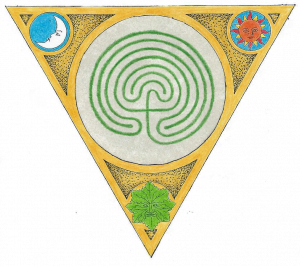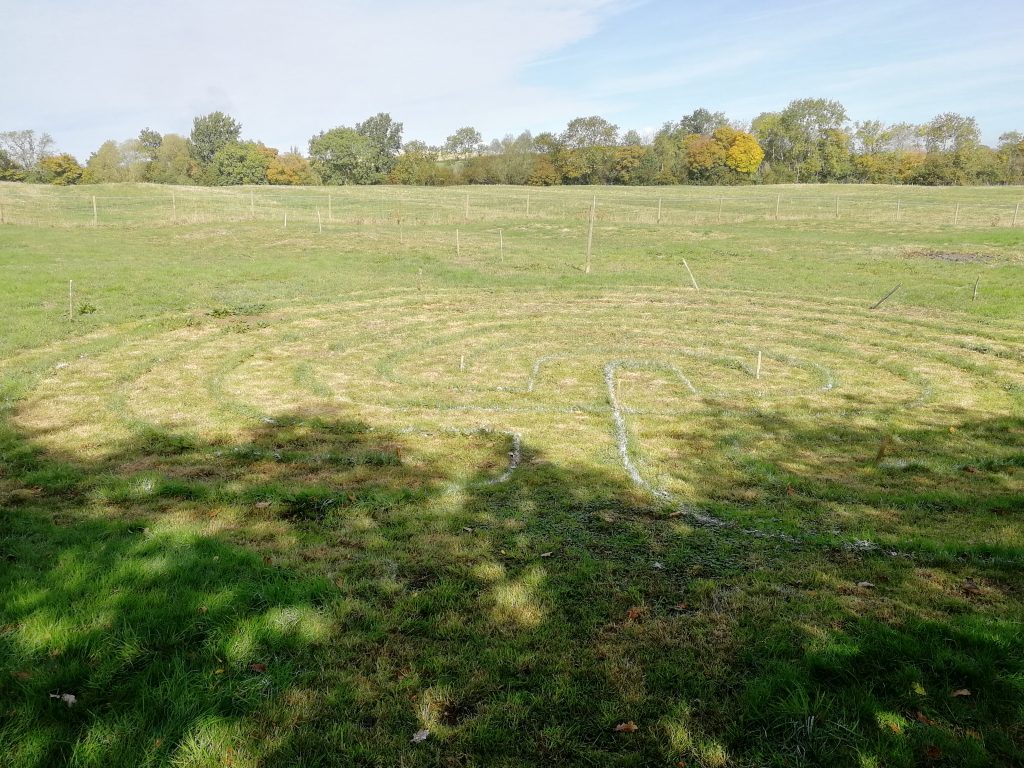Introduction
Unlike the Maze, which began to appear around six hundred or so years ago in medieval gardens and grand estates, the origins of the Labyrinth and their design and creation, reach much further back into the history of man for more than 4ooo years, and is often shrouded in myth and legend, in connection with many diverse cultures throughout the world, including the Ancient Greeks and the Romans.
As a design, the Labyrinth was first carved into wood, stone, and adorned pottery in the Bronze Age Neolithic period and could be followed with the tip of the finger. In time the Labyrinth began to expand and take its form marked out upon the ground and took on a whole new significance to a wide and diverse community.
Labyrinths were often marked or cut into the turf of Village Greens or local fields where they could be of access to everyone.
In the Middle Ages even the Church adopted the Labyrinth and introduced them to the entrances of Cathedrals, and examples can still be found today!
Unlike the Maze, with its multitude of twists, turns and dead ends designed to confuse, the Labyrinth is a single path, a single focus to follow toward the centre before continuing the pathway out of the Labyrinth!
Through the ages, journeying the Labyrinth has been seen as a calming, relaxing and meditative experience and it is said that, to walk the Maze is to lose oneself, but to walk the Labyrinth is to find oneself!
Traditionally, although there are countless design possibilities for a Labyrinth, there are two recognised designs, the first is known as the ‘Classical’ design and the other being the ‘Medieval’ design which tends to be more intricate and fancier, tending to represent the complexities of religious faith and understanding!
The ‘Classical’ design is more in keeping with the ancient Pagan tradition and understanding with the elegant curves of the Great Goddess and her connection with the Earth and the natural world.
The Sunwheel Grove Labyrinth
When we first found the possibility of a site for our Grove, we accepted that although the site was perfect, we would have to manage our expectations and compromise on what would be included.
It was agreed that to give everything the space that was needed, we would have to put the idea of building a Labyrinth on hold as we laid out the Grove and its design, rather than trying to squeeze everything in and cramping the site.
We have been more than happy with the situation, and the Grove and its design have now become a real home, with its layout and flow giving everything the room to breathe and creating its own microclimate.
However, over the last couple of years or so, we have been in discussions over the possibility of extending a part of our border, with the happy news that recently, we were given the go-ahead to expand the size of the site.
As we move forward, we will now be in a position to set out our very own Labyrinth, we are hopeful that with the extra space, our patience will be rewarded and following the Pagan tradition, we aim to include a Labyrinth in the ‘Classical’ style, as an enhancing feature, giving it both the space and respect that it deserves, as an important and welcome addition to our own overall Sunwheel Grove layout!
Some years ago, as a collective, we were inspired by a chance discovery at the Rollright Stones and the Whispering Knights Project, which included various forms of Natural Art, and in particular a ‘Classical’ Labyrinth, set out within the living woodland. It reinforced our own hopes and wishes of including a Labyrinth at the Grove at such a time we would have the room to do it justice. It also reinforced our thoughts as to which design we would choose, despite the seemingly endless possibilities, we agreed that it was only fitting that we would go with the ‘Classical’ design.
We would very much like to share the details of our up-and-coming project, the setting out and hosting of the Labyrinth with submissions, with links to our blog and additions to the page below, hopefully including both text and images of our adventures and experiences!
And So, It Begins!
In 2024, it was confirmed that we were able to extend our border from the West to the North of our existing Grove site. In the early spring of 2025, The Planning and Maintenance Dept. convened over the coming month or so and designed a plan to use the additional space in a practical, open and natural way.
Our design begins at the old school gates located next to the utility area and the beginning of the original Grove entrance pathway in the West.
Firstly, the plan is to plant a dividing hedge-line across the width of Yonderland, (as it’s referred to in the Grove Diary Blog) to form two squares, a small car park to hold up to half a dozen cars to the left and an enclosed and private space to house the Labyrinth to the right. Between them we hope to have a small avenue leading to an entrance way in the dividing hedge-line, which will then open out onto a wildflower meadow reaching all the way down to a wildlife pond at the end in the North.
The plan is to plant the dividing hedge-line and a hedgerow running down either side of the avenue, enclosing both the car park and the Labyrinth.
Over the course of the Summer, we have taken the opportunity to mark out this plan and define the new hedge lines, we intend to start with a simple wooden railed fence and then plant a natural native hedge through it.
Over the last month or so, we have been in a position to finally mark out the shape and form of our ‘Classical’ Labyrinth – please see the image below!
For a clearer view of our ‘Classical’ Labyrinth layout and design, please see the centre circle of the triangular image in the top left-hand corner of this page!
As we move forward, over time, we hope to continue to document the evolution of the Labyrinth and its design and creation, with further text, images and in conjunction with our ‘Grove Diary’ Blog!
Hawk Elderin & Morien Ravenstone
On behalf of The Sunwheel Grove Druid Order


